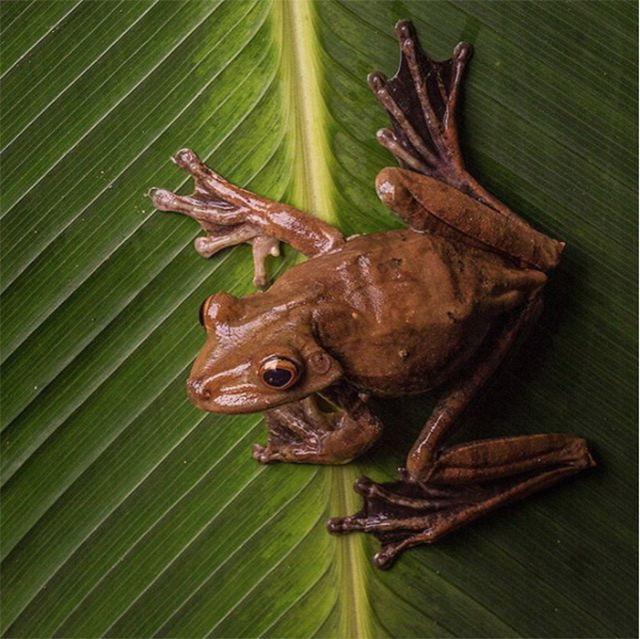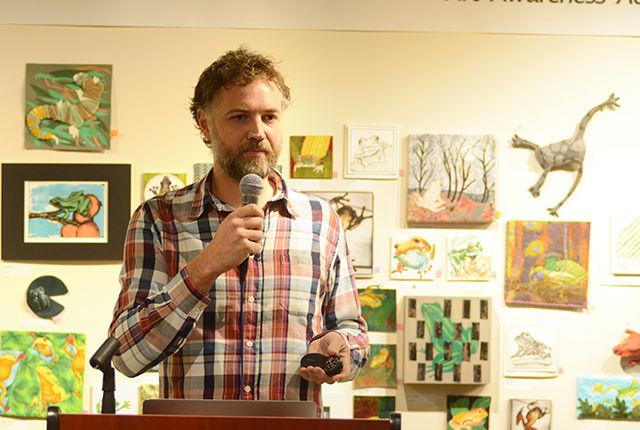As an extension of the Craft Center’s Disappearing Frog Project exhibit, award-winning National Geographic photographer Robin Moore spoke Thursday about his book, “In Search of Lost Frogs,” and his experiences with amphibians and amphibian decline.
Amphibians have survived the last four great extinctions, with the most recent occurring 65 million years ago. If a species could handle major environmental fluctuations, from ice ages to meteor collisions, what changes are so radical that amphibians are disappearing at such alarming rates?
Scientists speculate the environment is currently experiencing a sixth mass extinction largely caused by human activity. At present, the most concerning effects are found in amphibians, with more than half of all species believed to be at risk of extinction. While humans can account for much of the influx of new problems, such as habitat loss and pollution, more enigmatic factors seem to be at play. Frogs are disappearing from even the most protected, untouched environments. A hidden threat is wiping out entire colonies throughout the tropics with unprecedented speed.
The Search for Lost Frogs was in response to this global problem. Launched in August 2010, the search was unprecedented in both scope and magnitude. The campaign hoped to find amphibians that had been “lost,” those that had been missing for 10 years or more.
“Through my work, I was traveling to these amazing places, and I always loved photography,” Moore said. “I realized that through photography, you come back from a place, and you can share it with people; you can share what’s happening on the ground.”
The main suspect is a fungal disease found on infected frogs’ skin. Chytridiomycosis, an infection of debated origin, blocks the skin’s semi-permeable pores and eventually leads to cardiac arrest. The disease both spreads and eradicates rapidly, possessing the ability to drive mass amounts of frogs to extinction. With this extinction comes myriad environmental effects.
“When you remove them from the environment, the environment suffers, we suffer,” Moore said. “They are a very important link in the food chain, as predators and prey. It’s so often that we don’t know until an animal is gone what value it has to us.”
Along with documentation from press, the search published blog articles from the field, acting as an open invite for people to join the journey. It was not only a way to record re-emerging and newly discovered amphibians but why it was happening — and in turn, gave amphibian decline a tangible identity. Moore’s photos and his journey, as documented in “In Search of Lost Frogs,” acts as a bridge between art and science, with a goal to culture an appreciation and mindfulness for one of Earth’s most diverse populations.
“Images of endangered species can bring these animals to life for people,” said Don Church, executive director of the Amphibian Survival Alliance. “If they [people] don’t see them, if they don’t begin to have some level of at least empathy for them, no one’s going to do anything about trying to save them.”
Awareness of this problem is imperative for amphibian survival. The reemergence of some amphibians doesn’t mean the problem isn’t still growing, but it does signal new hope in understanding the problem more comprehensively.
“…We need to see that conservation and human well-being — quality of life — are closely tied,” Moore said. “Documenting success stories, stories of people who are effectively doing conservation is as important, possibly more important, than communicating what we’re losing. We ought to know what we’re working toward.”
The Disappearing Frogs Project is on display in the Crafts Center through Thursday.
Robin Moore speaking on his project titled "Disappearing Frogs" on Thursday, Feb. 25 2016 in the Crafts Center located in Thompson Hall. His project features photos of endangered species of frogs from Cenral America and all over the World that him and his colleagues are working to conserve.









